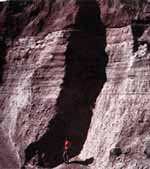 | 
Sequence of Strata Depositions

Up to 600 feet thickness of new strata have formed since 1980 at Mt. St. Helens.
Causes of depositions 
| 1. Primary air blasts
2. Landslide
3. Wave on the lake
4. Pyroclastic flows: 
| "a dense, turbulent avalanche or ground-hugging slurry of gases and volcanic fragments created at the neck of a volcano by an explosive, magmatic eruption."
| | 
| 
| There were 6 eruptions in 1980 with pyroclastic flows:  | May 18, May 25, June 12, July 22, August 7, and October 18-19. | | 5. Mudflows
6. Air fall (ash fallout)
7. Stream water

The nature of the deposits 
| Extensive strata with very thin laminae and cross-bedding
Course and fine sediments were separated into distinct strata by the flow process
 | |  | Causes of erosion 
| 1. Steam blasts: 
| Energy equivalent to 20,000 tons of TNT in north direction caused hot gas and rock abrasion
| 2. Debris avalanche: 
| rock, ice and debris movement caused abrasion
| 3. Water waves: 
| one-quarter of the avalanche landed in the lake causing a wave 860 feet high to erode the adjacent slopes
| 4. Pyroclastic flows: 
| volcanic ash and steam traveled along the ground at temperatures estimated at 950o C
| 5. Mudflows: 
| melted glacier ice pouring down the mountain collected volcanic ash and eroded soft volcanic deposits as well as hard rock
| 6. Jetting steam: 
| glacier ice buried by hot ash exploded forming pits
| 7. Water in channels: 
| overflowing caused rill and gully patterns, even on level slopes
| 
|
Specific areas:
 Toutle River cross-section Toutle River cross-section
 Loowit Canyon cross-section Loowit Canyon cross-section
 Steam explosion pits Steam explosion pits

Reference

| Austin, Lumsden, Morris, and Vardiman. Mt. St. Helens Tour Guidebook. Institute for Creation Research, 1997. | 
 |

